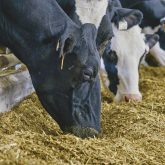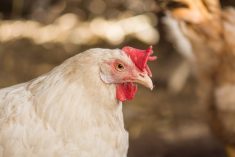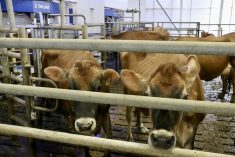New guidelines for dairy cattle care will improve animal welfare while also potentially increasing farm productivity, Dairy Farmers of Canada says.
“I think that we’ve come to a very solid revised code,” David Wiens, DFC’s vice-president, said in an interview.
The National Farm Animal Care Council (NFACC) on Thursday released its revised Code of Practice for the Care and Handling of Dairy Cattle, to take effect on April 1, 2024.
The code forms the backbone of DFC’s proAction quality assurance program, to which all dairy farms must adhere.
Read Also

Ample supplies and improved livestock sector to boost Canadian feed sector: FCC
Abundant feed grain supplies and improved profitability for the livestock sector should support strong feed demand and sales through the winter, says a new report from Farm Credit Canada.
Key changes to the code involve a timeline to eliminate tie-stall housing for cows, a system in which the animals are tethered continuously or for long periods. Effective April 2027, cows may not be tethered continuously. New barns will be required to allow “daily, untethered freedom of movement and social interactions year-round,” the code says.
By 2031, calves will be required to be housed in groups or pairs by four weeks of age. If they’re housed outdoors or in hutches, they may only be tethered if they can move in and out of the hutch. They must also be able to have physical contact with another calf, unless they need to be separated for health and safety reasons.
“Both of these changes are supported by science in terms of promoting good overall animal welfare,” Wiens said.
Both changes garnered praise from Humane Canada, a federation of humane societies and societies for the prevention of cruelty to animals (SPCAs). Humane Canada is one of the founding members of the NFACC and sat on the committee that oversaw the code’s revision.
“Overall we feel positive about the improvements in the code,” said Kathy Duncan, director of national programs with Humane Canada.
Nearly two thirds of Canadian dairy farms use tie-stall housing, Duncan said, and the previous code of contact took no steps toward eliminating the practice. Though Humane Canada is disappointed in the length of the phase-out periods for the changes, she said they are steps in the right direction.
“There are a number of areas of improvement,” Duncan said.
She highlighted added requirements that are intended to address animal abuse and work to ensure low-stress handling.
“We’ve seen some pretty horrific video of different types of handling on-farm and in slaughter,” Duncan said.
There are also stronger requirements and recommendations for oversight of farm workers.
Allowed stocking density will also decrease to 1.1 cows per stall in a free stall system from 1.2 cows per stall, effective April 2027. As of April 2031, that will be reduced to one cow per stall.
Wiens said he already stocks below the allowed rate.
“We find that cows are actually more productive at a slightly lower stocking rate,” he said.
The 2023 code notes that with lower stocking rates, cows have more access to feed bunks and can spend more time lying down — particularly for less dominant cows.
The code doesn’t include requirements for emergency preparedness planning, which is a disappointment, said Duncan. She pointed to the 2021 floods in B.C., which inundated many farms, including dairy farms. Many animals died, and other were left stranded and in dire need of food and water, according to one CBC report from November 2021.
The code contains many recommendations for emergencies, including the suggestion to develop a plan for evacuating cattle. It references “comprehensive resources to support emergency planning” that are separate from the code.
The code attracted “overwhelming interest” from Canadians, Duncan said.
Nearly 6,000 individuals or groups responded during the public consultation for the code, NFACC documents show. Forty per cent identified as dairy producers, just over 31 per cent were concerned citizens or animal welfare advocates, and just over 17 per cent identified as consumers.
— Geralyn Wichers is a reporter for the Manitoba Co-operator.
CLARIFICATION, April 4, 2023: A previous version of this article stated the updated code would require the elimination of tie stalls as of April 2027. Specifically, the code calls for elimination of tie stall housing, meaning the continuous or lengthy tethering of dairy cows in their stalls. The article has been edited to further clarify.

















